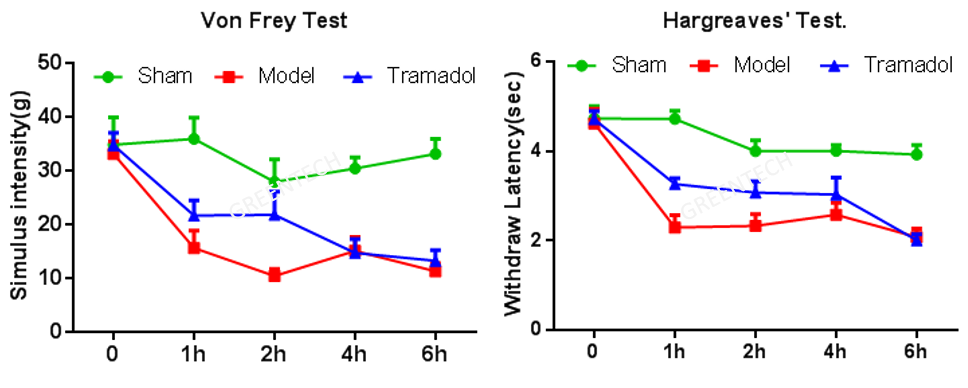Models of Inflammatory Pain
Acute inflammation is a normal physiological response to infection or injury, while chronic inflammation lasts for a long time and produces a considerable amount of adverse pain. However, treatments for inflammatory pain are limited by insufficient efficacy and various side effects. Greentech Bioscience offers multiple animal models of acute or chronic inflammatory pain for in vivo efficacy testing. Our animal model library also consists of a variety of inflammatory models.
Inflammatory Pain Models
Greentech has established multiple chemically induced inflammatory pain models including formalin-induced, capsaicin-induced, and CFA-induced models.
1. Formalin-Induced Pain Model
The formalin test has been routinely used for assessing pain and hyperalgesia. The formalin-induced inflammatory pain model is established by injecting formalin into the plantar surface of a rodent paw, producing nociceptive responses such as lifting, flinching, and licking of the injected paw. The formalin-induced inflammatory pain model involves typical biphasic nociceptive behavioral responses: immediate and intense phase 1 resulting from direct activation of primary nociceptive afferents, followed by a prolonged phase 2 arising through a combination of peripheral input and central sensitization.
Clinical assessment: time spent licking, lifting and flinching the injected paw after formalin injection, mechanical hyperalgesia, thermal hyperalgesia
2. Capsaicin-Induced Pain Model
Capsaicin is the active irritant found in chili peppers that has been used in preclinical studies to understand thermal pain. The capsaicin-induced pain model represents a safe, easy, reproducible experimental model of inflammatory pain. Administration of capsaicin into rat/mouse plantar surface produce primary and secondary hyperalgesia. Capsaicin-induced pain in rodents results in localized edema, paw limping and licking, as well as mechanical and thermal hyperalgesia.
Clinical Assessment: mechanical hyperalgesia, thermal hyperalgesia, etc.
3. CFA-Induced Inflammatory Pain Model
Complete Freund’s adjuvant (CFA) is a common agent used to induce chronic inflammatory pain in rodents. Chronic inflammatory pain involves peripheral tissue damage and harmful stimuli that locally increase the response, resulting in hyperalgesia and allodynia. CFA induced inflammation in rodents is constructed through an intraplantar injection of CFA in the hind paw, leading to inflammatory responses like locally edema and thermal hyperalgesia. An intra-articular injection of CFA in rodents can induce synovial inflammation, bone resorption and eventual degeneration, which is commonly used to assess inflammatory joint pain.
Clinical Assessment: mechanical hyperalgesia, thermal hyperalgesia, incapacitance test
Animal Species
Mice, rats
Case Study
CFA-induced model of inflammatory pain

References
1. Abboud C, et al. Animal models of pain: Diversity and benefits[J]. Journal of Neuroscience Methods, 2020.
2. Muley M M, et al. Preclinical Assessment of Inflammatory Pain[J]. CNS Neuroscience & Therapeutics, 2016, 22(2):88-101.
Inquiries
Request a quote now, or email us at BD@greentech-bio.com to inquire about our services or obtain a quote for your project.












